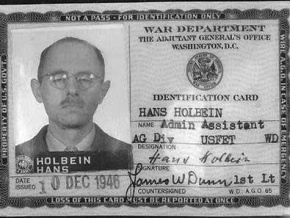Difference between revisions of "Reinhard Gehlen"
Jump to navigation
Jump to search
(lede) |
|||
| Line 15: | Line 15: | ||
|description=Forced out due to "political scandal within the ranks"}} | |description=Forced out due to "political scandal within the ranks"}} | ||
}} | }} | ||
| + | '''Reinhard Gehlen''' was head of the [[Gehlen Organisation]]. | ||
| + | |||
| + | ==Career== | ||
| + | After 1945, Gehlen's organisation, still under Reinhard Gehlen, began to work for US military intelligence. When the [[CIA]] was formed, Gehlen answered directly to them. | ||
[[image:Hans holbein.jpg|left|290px]] | [[image:Hans holbein.jpg|left|290px]] | ||
{{SMWDocs}} | {{SMWDocs}} | ||
{{Stub}} | {{Stub}} | ||
Revision as of 18:21, 12 December 2019
(soldier, spook) | ||||||||||||||
|---|---|---|---|---|---|---|---|---|---|---|---|---|---|---|
| File:Reinhard Gehlen.jpg | ||||||||||||||
| Born | 3 April 1902 Erfurt, German Empire | |||||||||||||
| Died | 1979-06-08 (Age 77) Starnberg, West Germany | |||||||||||||
| Founder of | Gehlen Organization | |||||||||||||
| Member of | Knights of Malta, Le Cercle | |||||||||||||
| ||||||||||||||
Reinhard Gehlen was head of the Gehlen Organisation.
Career
After 1945, Gehlen's organisation, still under Reinhard Gehlen, began to work for US military intelligence. When the CIA was formed, Gehlen answered directly to them.
Related Quotation
| Page | Quote | Author |
|---|---|---|
| Parastate | “The immediate concern of the United States was Europe, where it appeared that the French and Italian communist parties might be elected to power in 1948. From the beginning of the postwar era, Washington looked for assets and proxy armies of its own to combat the threat perceived from the Soviet Union and China. Some of these proxies like the the nationalist Chinese Kuomintang (KMT) troops in Burma or the Mafia's in Italy and Marseilles soon outgrew their US support to become de facto regional players or parastates, exhibiting some but not all of the properties of states in their own right. From 1945-1947, elements in the US army conspired to maintain contacts with former German anti-communists in Europe and their German army commander, General Reinhard Gehlen. 5 men were involved of whom 3 (William J. Donovan, Allen Dulles and Frank Wisner) were representatives of the Wall St. overworld and also of the New York Social Register which listed the members of New York high society. They were awaiting a new agency to succeed Donovan's Office of Strategic Services (OSS) and take over the Nazi's ethnic armies in Eastern Europe. But the idea of a centralised intelligence agency encountered fierce competitive opposition from the FBI's J. Edgar Hoover who was backed at first by elements of Army intelligence. Although it took 2 years to overcome their opponents, the Wall Street lawyers and bankers in Truman's administration succeeded in 1947 in establishing CIA, which would report to the president through the new National Security Council (NSC). This new agency, based on the precedent and personnel of the OSS had been urged on Washington by the War/Peace studies of the Council of Foreign Relations in the early 1940s. It was reinforced by a report commissioned in 1945 by Navy Secretary James V. Forrestal. The report was written by Ferdinand Eberstadt who like Forrestal was a private Wall Street banker from the investment bank, Dylan Reed. As CIA director Richard Helms narrates in his memoirs Allen Dulles, then a Republican lawyer in Sullivan and Cromwell in New York was recruited in 1946 to draft proposals for the shape and direction what was to become the new CIA. in 1947 Dulles promptly formed an advisory group of 6 men, all but one of whom were Wall St investment bankers or lawyers.” | Peter Dale Scott |
Related Document
| Title | Type | Publication date | Author(s) | Description |
|---|---|---|---|---|
| Document:Privatization for Dummies – The Nuts & Bolts of The World's Biggest Scam | article | 21 March 2019 | Ronald Thomas West |
Many thanks to our Patrons who cover ~2/3 of our hosting bill. Please join them if you can.
